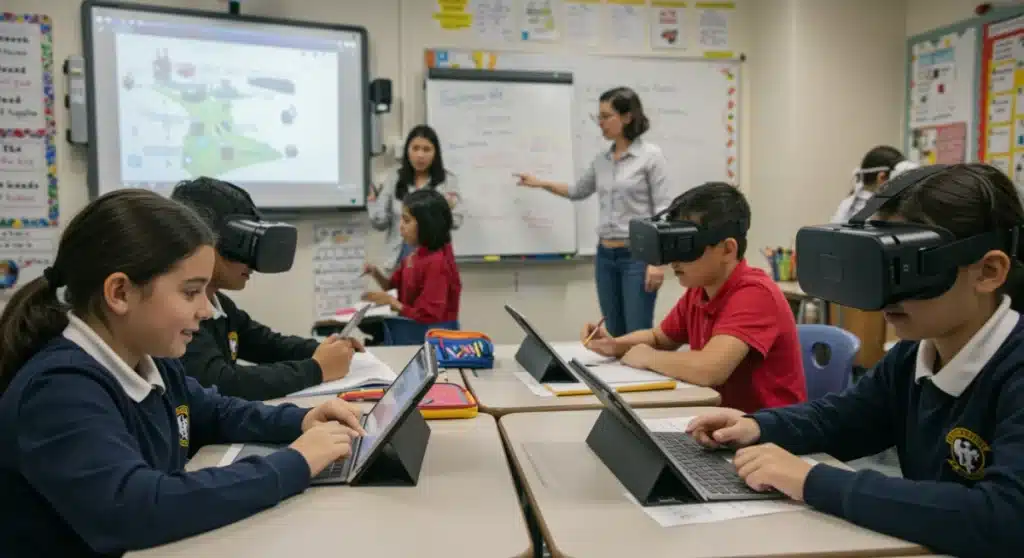K-12 EdTech Trends 2025: Enhancing Learning

Anúncios
The latest K-12 EdTech trends for 2025 are revolutionizing education by integrating practical solutions like AI, VR, and personalized learning platforms to enhance student engagement and outcomes across the United States.
Anúncios
The landscape of education is constantly evolving, and 2025 promises to be a pivotal year for K-12 institutions, particularly with the acceleration of technological integration. Understanding K-12 EdTech Trends is no longer an option but a necessity for educators, administrators, and parents seeking to provide the best possible learning environments. This article delves into the cutting-edge innovations that are not just theoretical concepts but practical solutions poised to transform how students learn and teachers teach, ensuring enhanced learning experiences across the board.
The rise of personalized learning pathways
Personalized learning, once a buzzword, is rapidly becoming a cornerstone of K-12 education. This approach tailors the learning experience to each student’s unique needs, interests, and pace, moving away from the one-size-fits-all model. Technology is the primary enabler of this shift, offering sophisticated tools that adapt to individual learners.
In 2025, personalized learning platforms are more advanced than ever, leveraging artificial intelligence (AI) and machine learning (ML) to provide dynamic content and assessments. These platforms can identify learning gaps in real-time and offer targeted interventions, ensuring no student is left behind while also challenging those who are ready for more complex material.
Anúncios
Adaptive learning technologies
Adaptive learning systems are at the forefront of personalized education, continuously adjusting the curriculum based on student performance. They utilize complex algorithms to analyze data from interactions, providing immediate feedback and modifying the learning path accordingly.
- Real-time assessment: Continuously evaluates student progress and understanding.
- Customized content delivery: Provides resources and activities tailored to individual needs.
- Differentiated instruction: Supports diverse learning styles and abilities.
- Data-driven insights: Offers educators actionable data to inform teaching strategies.
The integration of these technologies allows educators to manage diverse classrooms more effectively, fostering an environment where every student feels seen and supported. It shifts the teacher’s role from a sole knowledge dispenser to a facilitator and guide, empowered by data to make informed pedagogical decisions.
Ultimately, personalized learning pathways, powered by advanced EdTech, aim to cultivate a deeper understanding of subjects and foster lifelong learning skills. By catering to individual strengths and weaknesses, these systems are designed to maximize student potential and engagement, preparing them for future academic and professional challenges.
Artificial intelligence and machine learning in the classroom
Artificial Intelligence (AI) and Machine Learning (ML) are no longer futuristic concepts; they are actively shaping the K-12 classroom experience in 2025. These technologies offer unprecedented opportunities to automate administrative tasks, provide intelligent tutoring, and analyze vast amounts of educational data to improve outcomes.
From AI-powered grading systems that free up teachers’ time to intelligent chatbots that can answer student queries 24/7, AI is streamlining operations and enhancing learning support. The ethical implications and responsible implementation of these tools are also a growing focus, ensuring equity and privacy for all students.
AI-powered assessment and feedback
AI tools can revolutionize how assessments are conducted and feedback is delivered. Beyond automated grading of multiple-choice questions, AI can now analyze written responses, provide constructive criticism, and even identify patterns in student errors that might indicate a need for reteaching a specific concept.
- Automated grading: Reduces teacher workload, allowing more focus on instruction.
- Personalized feedback: Offers specific suggestions for improvement based on individual submissions.
- Plagiarism detection: Utilizes advanced algorithms to ensure academic integrity.
- Predictive analytics: Identifies students at risk of falling behind, enabling early intervention.
The ability of AI to provide instant and tailored feedback is invaluable, as it allows students to learn from their mistakes immediately rather than waiting for a teacher to grade their work. This immediacy reinforces learning and encourages a growth mindset.
Moreover, ML algorithms can process complex datasets to identify trends in student performance, curriculum effectiveness, and teaching methodologies. This data-driven approach empowers educators and administrators to make more informed decisions about resource allocation, professional development, and curriculum design, ultimately leading to more effective educational strategies.
Virtual and augmented reality for immersive learning
Virtual Reality (VR) and Augmented Reality (AR) are transforming passive learning into active, immersive experiences within K-12 education. These technologies transport students beyond the classroom walls, allowing them to explore historical sites, dissect virtual organisms, or even journey through the human body, all from their desks.
By 2025, the accessibility and affordability of VR/AR hardware and software have significantly improved, making these tools more viable for widespread implementation in schools. The focus is on creating engaging content that aligns with curriculum standards and enhances understanding through experiential learning.
Enhancing science and history education
VR and AR offer unique opportunities to visualize complex concepts and historical events, making abstract ideas tangible and memorable. Imagine students exploring ancient Rome, conducting chemistry experiments in a risk-free virtual lab, or observing planetary motion firsthand.
- Virtual field trips: Explore remote locations and historical landmarks without leaving the classroom.
- Interactive simulations: Conduct experiments and observe phenomena in a safe, controlled virtual environment.
- 3D modeling and visualization: Understand complex structures, such as human anatomy or molecular bonds, in an immersive manner.
- Gamified learning experiences: Engage students through interactive quests and challenges within virtual worlds.
These immersive technologies not only boost engagement but also cater to different learning styles, particularly visual and kinesthetic learners. By allowing students to interact with educational content in a multi-sensory way, VR and AR foster deeper comprehension and retention of information.
The integration of VR and AR in K-12 education is about creating memorable learning moments that spark curiosity and inspire a passion for discovery. As these technologies continue to evolve, their potential to revolutionize how students interact with and understand the world around them is immense.
The proliferation of digital citizenship and cybersecurity education
As technology becomes more deeply embedded in education, the importance of digital citizenship and cybersecurity education has soared. In 2025, K-12 schools are not just teaching students how to use technology, but how to use it responsibly, safely, and ethically. This includes understanding online etiquette, privacy, cyberbullying, and protecting personal information.
With students spending an increasing amount of time online for learning and social interaction, equipping them with the knowledge and skills to navigate the digital world securely is paramount. This curriculum is becoming as fundamental as traditional subjects, reflecting the realities of the modern age.
Key components of digital literacy
Digital literacy goes beyond basic computer skills; it encompasses a broad range of competencies necessary for thriving in a digital society. Schools are implementing comprehensive programs that cover various aspects of online safety and responsible digital behavior.
- Online safety and privacy: Educating students on protecting personal data and recognizing online threats.
- Cyber ethics and responsible use: Teaching appropriate online conduct and the impact of digital actions.
- Media literacy: Developing critical thinking skills to evaluate information consumed online.
- Cyberbullying prevention: Fostering empathy and providing strategies to address and report cyberbullying.
Integrating these topics into the curriculum prepares students to be informed, respectful, and safe participants in the digital realm. It’s about empowering them to leverage technology’s benefits while mitigating its risks, fostering a generation of responsible digital citizens.
Furthermore, cybersecurity education is crucial for safeguarding school data and systems. Students are also being introduced to basic cybersecurity principles, which not only protects them but also potentially inspires future careers in this vital field. The goal is to create a secure and respectful digital learning environment for all.
Enhanced collaboration and communication tools
Collaboration and communication are vital skills for the 21st century, and EdTech in 2025 is providing increasingly sophisticated tools to foster these abilities in K-12 students. Beyond simple video conferencing, these platforms offer integrated environments for group projects, shared document creation, and seamless interaction between students, teachers, and even parents.
The emphasis is on creating digital spaces that mirror real-world collaborative work environments, preparing students for future academic and professional settings. These tools break down geographical barriers, allowing for diverse perspectives and enriching learning experiences.
Integrated learning management systems (LMS)
Modern Learning Management Systems (LMS) are evolving into comprehensive hubs that support all aspects of collaborative learning. They integrate various tools, from discussion forums and shared whiteboards to project management features, all within a single, user-friendly interface.
- Real-time document collaboration: Students can work together on assignments simultaneously.
- Interactive discussion boards: Facilitate peer-to-peer learning and critical discourse.
- Project management features: Help students organize tasks, track progress, and assign roles within group projects.
- Parent-teacher communication portals: Streamline updates on student progress and school announcements.
These platforms not only enhance student-to-student and student-to-teacher communication but also empower parents to be more involved in their child’s education. By providing transparent access to assignments, grades, and ongoing projects, LMS platforms create a more connected educational ecosystem.
The evolution of collaborative tools in K-12 EdTech is about building a community of learners who can effectively share ideas, solve problems together, and communicate clearly across various digital mediums. These skills are indispensable for success in an increasingly interconnected world.
Sustainable and accessible EdTech solutions
As K-12 EdTech continues to advance, a critical focus for 2025 is on developing sustainable and accessible solutions. This means not only environmentally friendly practices but also ensuring that technology is available and usable by all students, regardless of their socio-economic background, location, or learning disabilities.
The push for equity in education technology is driving innovations in affordable hardware, open-source software, and robust infrastructure development, particularly in rural and underserved areas. Accessibility features are no longer an afterthought but are integrated into the design process from the outset.
Bridging the digital divide
Efforts to bridge the digital divide are intensifying, recognizing that equitable access to technology is fundamental for equitable educational opportunities. Initiatives include providing devices, internet access, and digital literacy training to students and families who lack these resources.
- Affordable device programs: Schools and districts are implementing programs to provide laptops or tablets to students.
- Expanded internet access: Collaborations with local governments and ISPs to ensure home internet connectivity.
- Open educational resources (OER): Utilizing free and openly licensed educational materials to reduce costs.
- Assistive technologies: Integrating tools like screen readers, voice-to-text, and adaptive keyboards for students with disabilities.
Sustainability in EdTech also involves considering the lifecycle of devices and the environmental impact of technology production and disposal. Schools are increasingly prioritizing vendors who offer eco-friendly products and services, emphasizing repairability and recycling programs.
The commitment to sustainable and accessible EdTech ensures that the benefits of technological advancements reach every student, fostering an inclusive learning environment. It’s about designing solutions that are not only innovative but also responsible and equitable, building a foundation for lifelong learning for all.
| Key Trend | Brief Description |
|---|---|
| Personalized Learning | Tailoring education to individual student needs using AI and adaptive platforms. |
| AI & Machine Learning | Automating tasks, providing intelligent tutoring, and data analysis for improved outcomes. |
| VR & AR Immersive Learning | Creating engaging, experiential learning environments for complex subjects. |
| Digital Citizenship | Educating students on responsible, safe, and ethical technology use and online behavior. |
Frequently asked questions about K-12 EdTech in 2025
Personalized learning will shift teachers from primary knowledge dispensers to facilitators. They will use data from adaptive platforms to guide individual students, provide targeted support, and focus on higher-order thinking skills, making their role more strategic and impactful in the learning process.
Key ethical concerns include data privacy and security, algorithmic bias in assessment, and the potential for over-reliance on technology reducing human interaction. Ensuring equitable access and transparent AI usage are also critical considerations for responsible implementation in schools.
While costs are decreasing, full-scale VR/AR implementation can still be a challenge for some. However, more affordable options like smartphone-based AR apps and classroom VR kits are becoming available. Grant programs and open-source content also aid in making these immersive technologies more accessible.
Effective digital citizenship education requires a comprehensive, integrated approach. It should involve regular curriculum updates, consistent reinforcement across subjects, active parent involvement, and practical, real-world scenarios. Fostering open dialogue about online experiences is also crucial for success.
Parents are crucial partners in supporting EdTech trends by encouraging responsible device usage, monitoring online activity, and engaging with school communication platforms. Their involvement in fostering a positive home learning environment and understanding new technologies reinforces classroom efforts and student success.
Conclusion
The trajectory of K-12 education technology in 2025 points towards a future where learning is more personalized, immersive, and interconnected than ever before. From adaptive AI systems to captivating VR experiences, these innovations are not just about introducing gadgets but about fundamentally enhancing the educational journey. By embracing these K-12 EdTech Trends and focusing on practical, accessible, and sustainable solutions, schools can better prepare students for the complexities of the modern world, fostering critical thinking, collaboration, and a lifelong love of learning. The ongoing commitment to integrating these technologies responsibly will be key to unlocking their full potential and transforming K-12 education for generations to come.





